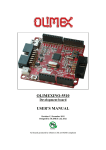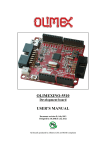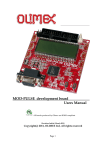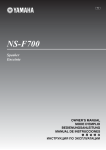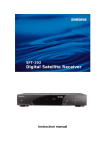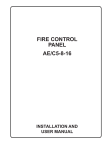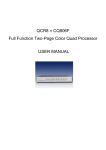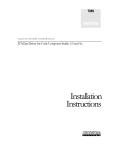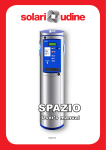Download MSP430-JTAG-ISO-MK2 USER'S MANUAL
Transcript
MSP430-JTAG-ISO-MK2 professional MSP430 programmer/debugger USER’S MANUAL Revision A, August 2012 Designed by OLIMEX Ltd, 2012 All boards produced by Olimex LTD are ROHS compliant OLIMEX© 2012 MSP430-JTAG-ISO-MK2 User's Manual DISCLAIMER © 2012 Olimex Ltd. Olimex®, logo and combinations thereof, are registered trademarks of Olimex Ltd. Other product names may be trademarks of others and the rights belong to their respective owners. The information in this document is provided in connection with Olimex products. No license, express or implied or otherwise, to any intellectual property right is granted by this document or in connection with the sale of Olimex products. It is possible that the pictures in this manual differ from the latest revision of the board. The software provided and the hardware design of MSP430-JTAG-ISO-MK2 are closed source and belong to OLIMEX LTD. The product described in this document is subject to continuous development and improvements. All particulars of the product and its use contained in this document are given by OLIMEX in good faith. However all warranties implied or expressed including but not limited to implied warranties of merchantability or fitness for purpose are excluded. This document is intended only to assist the reader in the use of the product. OLIMEX Ltd. shall not be liable for any loss or damage arising from the use of any information in this document or any error or omission in such information or any incorrect use of the product. This MSP430-JTAG-ISO-MK2 is intended for use for engineering development, demonstration, or evaluation purposes only and is not considered by OLIMEX to be a finished end-product fit for general consumer use. Persons handling the product must have electronics training and observe good engineering practice standards. As such, the goods being provided are not intended to be complete in terms of required design-, marketing-, and/or manufacturing-related protective considerations, including product safety and environmental measures typically found in end products that incorporate such semiconductor components or circuit boards. Olimex currently deals with a variety of customers for products, and therefore our arrangement with the user is not exclusive. Olimex assumes no liability for applications assistance, customer product design, software performance, or infringement of patents or services described herein. THERE IS NO WARRANTY FOR THE DESIGN MATERIALS AND THE COMPONENTS USED TO CREATE MSP430-JTAG-ISO-MK2. THEY ARE CONSIDERED SUITABLE ONLY MSP430-JTAG-ISO-MK2. Page 2 of 22 OLIMEX© 2012 MSP430-JTAG-ISO-MK2 User's Manual Table of Contents DISCLAIMER............................................................................................................. 2 CHAPTER 1: OVERVIEW........................................................................................4 1. Introduction to the chapter....................................................................................................4 1.1 Features..............................................................................................................................4 1.2 Target market and purpose of the device........................................................................5 1.3 Organization of this document.........................................................................................5 CHAPTER 2: REQUIREMENTS AND FIRST START-UP...................................6 2. Introduction to the chapter....................................................................................................6 2.1 Electrostatic warning........................................................................................................ 6 2.3 Hardware requirements....................................................................................................6 2.4 Software requirements......................................................................................................6 2.5 First time start-up............................................................................................................. 7 CHAPTER 3: MSP430-JTAG-ISO-MK2 BOARD DESCRIPTION.....................8 3. Introduction to the chapter....................................................................................................8 3.1 Basic device description....................................................................................................8 CHAPTER 4: MODES OF OPERATION.............................................................. 10 4. Introduction ot the chapter..................................................................................................10 4.2 Debugger mode....................................................................................................................11 4.3 Mass storage mode .............................................................................................................12 4.4 Stand alone mode................................................................................................................13 4.4.1 Opening an existing project.........................................................................................14 4.4.1.1 Editing the open project........................................................................................... 14 4.4.1.2 Writing in an existing project...................................................................................15 4.4.4 Reading from a microcontroller “READ”.................................................................16 CHAPTER 5: OPJ file format..................................................................................17 CHAPTER 6: DIMENSIONS...................................................................................19 6. Introduction to the chapter..................................................................................................19 CHAPTER 7: REVISION HISTORY, WEB LINKS AND SUPPORT................20 7. Introduction to the chapter..................................................................................................20 7.1 Document revision.............................................................................................................. 20 7.2 Device revision.....................................................................................................................20 7.3 Useful web links and purchase codes................................................................................21 7.4 Product support.................................................................................................................. 22 Page 3 of 22 OLIMEX© 2012 MSP430-JTAG-ISO-MK2 User's Manual CHAPTER 1: OVERVIEW 1. Introduction to the chapter Thank you for choosing the MSP430-JTAG-ISO-MK2 debugger/programmer! This document provides a user’s guide for the Olimex MSP430-JTAG-ISO-MK2. As an overview, this chapter gives the scope of this document and lists the board’s features. The document’s organization is then detailed. The MSP430-JTAG-ISO-MK2 programmer/debugger development board enables code uploading of applications running on MSP430 microcontrollers, manufactured by Texas Instruments. The product is our most sophisticated MSP430 programmer/debugger and has many improvements over the our previous MSP430 tools. 1.1 Features Supports both JTAG and SBW interfaces Ultra fast programming 14KB/s faster several times than TI-USB-FET (1.4KB when spy-biwire) Opto-isolation 1000VDC, target circuit can be high voltage powered (electricity meters safe debugging) Can burn the MSP430 JTAG security fuse LCD display for convenient navigation between different modes of operation 1,76 GB internal memory available for custom code (Stand alone mode) or mass storage 3-different modes of operation – Debugger, Mass storage, Stand alone Can be powered either by external power or the USB interface Extended firmware features – target voltage display, target current consumption display Sleek and solid black case Easy navigation via 4 analog buttons Sophisticated custom-made front panel MSP430.dll makes it compatible with all existing software which works with TI-USB-FET (emulates TI-USB-FET) compatible with all MSP430 programming and debugging software 14-pin JTAG ribbon cable included Dimensions: 75mm x 111mm (2.95'' x 4.37") Page 4 of 22 OLIMEX© 2012 MSP430-JTAG-ISO-MK2 User's Manual 1.2 Target market and purpose of the device MSP430-JTAG-ISO-MK2 is suitable for programming and debugging all Texas Instruments MSP430 microcontrollers which support JTAG or SBW (Spy-Bi-Wire) interfaces. The device is recommended for all MSP430 fans. It is especially convenient for mass production due to the ease of stand-alone programming and the ability to power targets. 1.3 Organization of this document Each section in this document covers a separate topic, organized as follow: – – Chapter 1 is an overview of the board usage and features Chapter 2 lists the additional software and hardware means you might need for proper use of the device – – Chapter 3 contains detailed description of the board peripherals and the basic controls Chapter 4 describes the modes of operation: the MSP430-JTAG-ISO-MK2 microcontroller – – Chapter 5 is an explanation of the file format used for stand-alone programming Chapter 6 shows the dimensions of MSP430-JTAG-ISO-MK2 – Chapter 7 contains the revision history, the useful web links and support information Page 5 of 22 OLIMEX© 2012 MSP430-JTAG-ISO-MK2 User's Manual CHAPTER 2: REQUIREMENTS AND FIRST START-UP 2. Introduction to the chapter This section helps you set up the MSP430-JTAG-ISO-MK2 development board for the first time. Please consider first the electrostatic warning to avoid damaging the board, then discover the hardware and software required to operate the board. The procedure to power up the board is given, and a description of the default board behavior is detailed. 2.1 Electrostatic warning MSP430-JTAG-ISO-MK2 is shipped in a protective anti-static package. The board must not be exposed to high electrostatic potentials. A grounding strap or similar protective device should be worn when handling the board. Avoid touching the component pins or any other metallic element. 2.3 Hardware requirements The board can be powered either by the USB or by +12V external source. If you use the USB note that the connector is type B – to connect to a personal computer you will probably need USB-A to USB-B cable which is not included in the package. You can purchase such a cable from us, the code is: USB-CABLE - USB standard type A to USB standard type B cable Powering the board from external source is very convenient for stand alone mode since you don't need to be connected to a personal computer once you have uploaded the needed files on the SD card. 2.4 Software requirements You will need a software set of tools to be able to debug with MSP430-JTAG-ISO-MK2 in debugger mode. We distribute a free programmer software that can be used with MSP430-JTAG-ISO-MK2. Page 6 of 22 OLIMEX© 2012 MSP430-JTAG-ISO-MK2 User's Manual We have tested the device with the latest “Code Composer Studio” and “IAR embedded work bench for MSP430”. 2.5 First time start-up Setting up the MSP430-JTAG-ISO-MK2 for development purposes might vary between different users. However, at least a personal computer with a working USB port and a cable USB type A to USB type B are required. Connect the device to the computer via the cable. At first the device won't show as a new or recognized device. Depending on your choices in the menu such will be required for proper operation. In debugger mode you will need A new device should be recognized by your device manager. You need to install the latest drivers that can be downloaded from our web site. Navigate to MSP430 section and then to the web page of MSP430-JTAG-ISO-MK2 they are located in the software section. After downloading and extracting the archive plug the debugger to the computer and enter “debugger mode” with the right arrow. You will then discover new unrecognized device in device manager. Right click over it and point the installer to “Drivers” folder from the archive. Ignore the warning and the drivers should install successfully. After successful installation of the drivers and when in debugger mode the device should be shown in device manager as show below: It might be a good idea at this point to change the COM port number to a free one in the 1-4 range since some software tools does not enumerate all COM ports. You will also need to replace the MSP430.dll in your software tools (e.g. IAR EW for MSP or Code Composer Studio) driver's folder with the one downloaded from our web-site. This is a required step to ensure that your software will work with our product. The usual location of the .dll for IAR EW for MSP is \IAR Systems\Embedded Workbench x.x\430\bin. The usual location of the .dll for IAR EW for MSP is \Texas Instruments\ccsv4\DebugServer\drivers. Page 7 of 22 OLIMEX© 2012 MSP430-JTAG-ISO-MK2 User's Manual CHAPTER 3: MSP430-JTAG-ISO-MK2 BOARD DESCRIPTION 3. Introduction to the chapter Here you get acquainted with the main parts of the board and their location on the case. Some of the elements are named near their position on the case of MSP430-JTAG-ISO-MK2. 3.1 Basic device description In the table below are show the main parts of the board and their positioning on the case. MSP430-JTAG-ISO-MK2 description # Function 1 Display 2 Power LED 3 Status LED 4 Communication LED 5 Up/Increment button 6 Select button 7 Down/Decrement button 8 Mode/Back button 9 USB connector 10 JTAG/SBW connector 11 External power connector The functions supported are further explained in the next chapters of this document. Page 8 of 22 OLIMEX© 2012 MSP430-JTAG-ISO-MK2 User's Manual The LEDs functions are detailed in the table below LED COLOR MODE OF OPERATION MEANING RED ON INPUT POWER PRESENT GREEN ON INDICATES THE DEVICE IS PROPERLY WORKING BLINKING ERROR or UNDEFINED PROGRAMMER/DEBUGGER STATE BLINKING USB OR JTAG/SBW COMMUNICATION YELLOW It is not recommended to power down the board when the YELLOW LED is blinking. Page 9 of 22 OLIMEX© 2012 MSP430-JTAG-ISO-MK2 User's Manual CHAPTER 4: MODES OF OPERATION 4. Introduction ot the chapter In this chapter we will explain the mode options of MSP430-JTAG-ISO-MK2. Furthermore, a stepby-step guide to each option will be provided. Each option will be explained. MSP430-JTAG-ISO-MK2 has three modes of operation. Upon powering the device from external source of power (12V) or via the USB(5V) the screen should look like the image below. Main menu # Function 1 Mode select (up arrow key/increment button, down arrow key/decrement button) - mode select maker is used to navigate to desired new mode – the available modes are: Debugger, Mass Storage, Stand Alone 2 Current mode – current mode highlights the mode lastly used 3 Confirm selection (right arrow key/select button) – confirms our selected by mode-select choice Each of the modes selected are explained in the next sub-chapters. Generally, the up and down yellow arrows are used for selection (navigation), the right arrow (->) is used to confirm selection or execute a selection, the left arrow is used to return one level up in the menus. Page 10 of 22 OLIMEX© 2012 MSP430-JTAG-ISO-MK2 User's Manual 4.2 Debugger mode Debugger mode gives your IDE or software tools control over MSP430-JTAG-ISO-MK2 via the USB. Still the debugger gives you extra info about the microcontroller, the power and the consumption. Menu “Debugger” # Function 1 Current mode of operation debugger 2 Microcontroller type 3 Source of power: - EXT – shows the target is powered from external source (different than MSP430-JTAG-ISO-MK2) - INT – means the target is powered by the debugger/programmer 4 Shows microcontroller power in Volts 5 Shows current consumption – only if powering the target from the MSP430-JTAG-ISO-MK2 6 Change the mode (button Mode/Back button) Page 11 of 22 OLIMEX© 2012 MSP430-JTAG-ISO-MK2 User's Manual 4.3 Mass storage mode When connected in this mode to a computer, the computer would recognize the built-in SD card. You can then transfer OPJ files you have edited on the computer to the debugger or vice verse save to the computer files you have previously read with MSP430-JTAG-ISO-MK2. Additionally you are able to use the SD card as general purpose card if you suddenly need to save files and lack another storage at hand. Menu “Mass storage” # Function 1 Current mode of operation – mass storage 2 Change mode (Mode/Back button/Left button) Page 12 of 22 OLIMEX© 2012 MSP430-JTAG-ISO-MK2 User's Manual 4.4 Stand alone mode Stand alone mode is used when you need to program a number of devices with the same program or when you lack a computer near the device you need to program. However, you need to provide +12V DC to the jack in order to be able to use stand alone mode. Note that you never should apply more than 12.5V since that would damage the board or its components. Menu “Stand alone” # Function 1 Current mode of operation alone mode 2 Open an existing (previously saved) project 3 Highlighted operation (Up/Increment button, Down/Decrement button) 4 Create new project 5 Change mode (Mode/Back button) 6 Select the highlighted operation (Select button) stand The options in this menu let you either open the program file located on the SD card or read the memory of the currently connected MCU. Page 13 of 22 OLIMEX© 2012 MSP430-JTAG-ISO-MK2 User's Manual 4.4.1 Opening an existing project If you have selected the “Open” choice in the previous menu you will be presented with a list of available projects. Choosing the one you want to write to your device will lead you to a new menu. Sub-menu “Open” # Function 1 Sub-menu “OPEN” 2 Available projects 3 Highlight (Up/Increment button, Down/Decrement button) 4 Back to the upper menu (Mode/Back button) 5 Select the highlighted project (Select button) 4.4.1.1 Editing the open project Edit of the opened project gives provides a way to change some basic faster. Sub-menu “Edit” # Function 1 Sub-menu “EDIT” 2 Highlighted operation (Up/Increment button, Down/Decrement button) 3 Choosing the default programmer interface - JTAG - SBW - AUTO – automatically chooses JTAG Page 14 of 22 OLIMEX© 2012 MSP430-JTAG-ISO-MK2 User's Manual or SBW interface is available 4 Shows the current voltage of the microcontroller 5 Blows the READ fuse of the target (ON/OFF) 6 Back to the “Open” sub-menu (Mode/Back button) 7 Store the changes in the project (Select button) 4.4.1.2 Writing in an existing project Writing to the target board. If you program the same type of board with the same program you would probably stay just in this menu just pressing the right arrow button, switching the board and then again pressig the right arrow. Sub-menu “Write” # Function 1 Sub-menu “WRITE” 2 Microcontroller type 3 Interface used 4 READ protection fuse 5 Voltage of the microcontroller 6 Back to “EDIT” sub-menu (Mode/Back button) 7 Store (Select button) Page 15 of 22 OLIMEX© 2012 MSP430-JTAG-ISO-MK2 User's Manual 4.4.4 Reading from a microcontroller “READ” The “READ” option in “Stand alone” mode gives a chance to get the program of a standart MSP430 MCU which hasn't its read fuse blown. Sub-menu “Read” # Function 1 Sub-menu “READ” 2 Highlighted operation (Up/Increment button, Down/Decrement button 3 Programming interface 4 Voltage of the microcontroller 5 Reading the program from the microcontroller and creating a project file named the type of the microcontroller and consecutive number 6 Back to the main menu (Mode/Back button) 7 Select the highlighted operation (Select button) Page 16 of 22 OLIMEX© 2012 MSP430-JTAG-ISO-MK2 User's Manual CHAPTER 5: OPJ FILE FORMAT The default form of the OPJ file. It can be opened with a text editor for faster edit. It is useful to edit the OPJ file when you need to change only options in the programming mechanism, not the logic of the program. Some of the options can be modified only in the OPJ file. <?xml version="1.0" encoding="UTF-8"?> - xml header <ISO_V2> - ISO V2 section <!--Device ID--> - ID of the controller <!--Device interface – JTAG,SWD,AUTO--> - Interface type <!--Device voltage 1800-3600 mV--> - Controller voltage <Target Id="15" IF="JTAG" Vt="3000"/> - ON/OFF operation <!--Erase device – 0/1--> - Erasing <!--Blank check device – 0/1--> - Blank check <!--Programming device – 0/1--> - Programming <!--Verify device – 0/1--> - Verification <!--Blow device – 0/1--> - Read protection <!--File name--> - Program file name in TXT or HEX format <Programming Erase="1" Blank="1" Write="1" Verify="1" Blow="0" File="test.txt"/> <!--Serializing enable – 0/1--> - Serialization ON/OFF <!--Serial number format – HEX,BDC--> - Serial number format <!--Serial number endian – LE,BE32,BE8--> - Serial number endian <!--Serial number size - 1:4 bytes--> - Serial number size <!--Serial number start address--> - Serial number start address <!--Serial number--> - Current serial number <!--Last serial number--> - Last serial number <SN Enable="1" Format="HEX" Endian="LE" Size="4" Addr="1024" Count="0x80000000" Last="0xFFFFFFFF"/> <!--Sections preserve--> - Description of sections that would NOT be modified <Section> <!--Section start address--> - Section start address <!--Section size--> - Section size <Entry Start="0x11111111" Size="0x21111111"/> <Entry Start="0x31111111" Size="0x41111111"/> <Entry Start="0x51111111" Size="0x61111111"/> <Entry Start="0x71111111" Size="0x81111111"/> Page 17 of 22 OLIMEX© 2012 MSP430-JTAG-ISO-MK2 User's Manual <Entry Start="0x91111111" Size="0xA1111111"/> <Entry Start="0xB1111111" Size="0xC1111111"/> <Entry Start="0xD1111111" Size="0xE1111111"/> <Entry Start="0xF1111111" Size="0xFFFFFFFF"/> </Section> </ISO_V2> Note the section preserve part. It is very helpful when there are parts of the memory you don't wish to modify again. Page 18 of 22 OLIMEX© 2012 MSP430-JTAG-ISO-MK2 User's Manual CHAPTER 6: DIMENSIONS 6. Introduction to the chapter The MSP430-JTAG-ISO-MK2 comes in a plastic box. The dimensions of the box can be seen below: Note that all dimensions are in mils. Page 19 of 22 OLIMEX© 2012 MSP430-JTAG-ISO-MK2 User's Manual CHAPTER 7: REVISION HISTORY, WEB LINKS AND SUPPORT 7. Introduction to the chapter In this chapter you will find the current and the previous version of the document you are reading. Also the web-page for your device is listed. Be sure to check it after a purchase for the latest available updates and examples. 7.1 Document revision Revision Changes Modified Page# A, 01.08.12 Preliminary revision All B, 22.08.12 Initial release All 7.2 Device revision Revision K Notable Changes Initial release of the device Page 20 of 22 OLIMEX© 2012 MSP430-JTAG-ISO-MK2 User's Manual 7.3 Useful web links and purchase codes The web page you can visit for more info on your device is https://www.olimex.com/dev/MSP430JTAG-ISO-MK2.html. ORDER CODES: MSP430-JTAG-ISO-MK2 – professional programmer featuring LCD, SD card, stand-alone mode, 12V target supply USB-CABLE - USB type A to USB type B cable The latest price list can be found at http://olimex.com/dev/pricelist.html. How to order? You can order to us directly or by any of our distributors. Check http://www.olimex.com/ and http://olimex.com/dev/order.html for more info. Page 21 of 22 OLIMEX© 2012 MSP430-JTAG-ISO-MK2 User's Manual 7.4 Product support For product support, hardware information and error reports mail to: [email protected]. Note that we are primarily a hardware company and our software support is limited. Please consider reading the paragraph below about the warranty of Olimex products. Warranty and returns: Our boards have lifetime warranty against manufacturing defects and components. During development work it is not unlikely that you can burn your programmer or development board. This is normal, we also do development work and we have damaged A LOT of programmers and boards during our daily job so we know how it works. If our board/programmer has worked fine then stopped, please check if you didn't apply over voltage by mistake, or shorted something in your target board where the programmer was connected etc. Sometimes boards might get damaged by ESD shock voltage or if you spill coffee on them during your work when they are powered. Please note that warrany do not cover problems caused by unproper use, shorts, over-voltages, ESD shock etc. If the board has warranty label it should be not broken. Broken labels void the warranty, same applies for boards modified by the customer, for instance soldering additional components or removing components - such boards will be not be a subject of our warranty. If you are positive that the problem is due to manufacturing defect or component you can return the board back to us for inspection. When we receive the board we will check and if the problem is caused due to our fault and we will repair/replace the faulty hardware free of charge, otherwise we can quote price of the repair. Note that all shippings back and forth have to be covered by the customer. Before you ship anything back you need to ask for RMA. When you ship back please attach to it your shipping address, phone, e-mail, RMA# and brief description of the problem. All boards should be sent back in antistatic package and well packed to prevent damages during the transport. Page 22 of 22


























